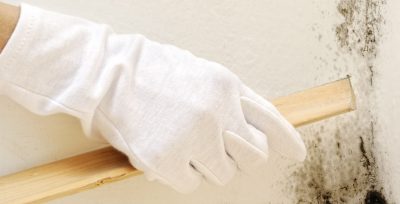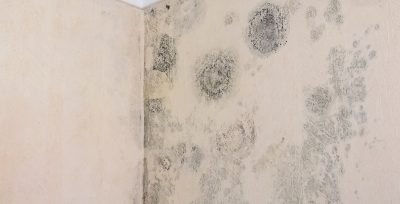Water seepage or its absorption into a wall are some of the causes of penetrating damp. Penetrating damp also affects ceilings, floors, and other parts of the building. The water unusually gains entry from the outside environment or faulty plumbing. Below given are some of the most leading causes of penetrating damp.
Wall Cracks
Large cracks in the exterior walls can provide a passage for the rainwater to make its way inside the construction. Cracks are very dangerous for the integrity of the building since they tend to grow in size rapidly. Even small, unnoticeable cracks can widen to easily allow the rainwater inside the building. The cracks will keep on getting bigger and bigger until they are adequately addressed and repaired.
Areas around door edges and window frames are the most susceptible to cracks, if not sealed properly. Cracks may also appear due to repeated movement at the windows and doors. While a new building might stay crack-free for some amount of time, it does not take long for cracks to appear with the increase in use.
Vibrations from nearby sources are another cause of crack formation in buildings. Railroad tracks or nearby construction sites can produce enough vibrations to initiate the formation of cracks. Low-quality construction and poor foundations also affect the integrity of the walls.
We recommend keeping an eye out for any new cracks that might appear in your building. Cracks need to be addressed quickly to eliminate the chances of any future damage to the property.
Rising and Penetrating Damp Prevention and Treatment Services in London
- 01Rising & Penetrating DampRead more
- 02What Is Penetrating DampRead more
- 03What is Rising DampRead more
- 04Causes of Rising DampRead more
- 05Causes Of Penetrating DampRead more
- 06Symptoms of Rising dampRead more
- 07Symptoms of Penetrating DampRead more
- 08Rising Damp vs Penetrating DampRead more
- 09Stop Penetrating DampRead more
- 10Stop Rising DampRead more
- 11What is a Damp Proof CourseRead more
Roof Leaks and Chimneys
Water can quickly gain entry into the building from areas with missing tiles or inefficient drainage systems. Damaged rafters also give rise to penetrating damp related problems.
While rooting out the damp source, it must be kept in mind that the area covered with damp might not always be the leakage site too. Water can travel long distances along with the different structures of your building, before making its way to the innermost surface. Wall edges, ceilings, and electrical fitting serve as the perfect medium for water to travel.
In most of the buildings where the damp source cannot be located, a faulty chimney is usually the culprit. Poorly sealed chimney points allow for the seepage of water into the lower levels of the building. In some buildings, the cowls may be damaged or not even installed in the first place. This provides a wide area for water to fall straight in.
Decayed or Faulty Pointing
Pointing is the cement material used to hold the masonry in a structure together. As time passes, it may deteriorate, either due to low quality or the lack of proper care and maintenance. That provides another way for the water to seep in from the gaps. Large cracks may appear from the freezing and subsequent thawing of the water in the gaps.
We recommend getting your brickwork repointed since it can be detrimental to the health of your building.
Faulty Gutters and Plumbing
Gutters and pipes can cause damp penetration into the building if they get damaged or blocked. Since the water cannot make its way forward, it comes back to the site of its origin.
Blocked gutters can be quickly unblocked, and if cracked, there are several easy fixes available. On the other hand, damaged plumbing is not so easy to repair or even spot. It is challenging and time-consuming to pinpoint the exact location of the leak since it is mostly covered and inaccessible. Invasive work is usually required to find and fix the damaged piping.
When it comes to the different pipe types, the old hot water pipes made out of copper are more likely to develop leaks or even cracks.
How Can I Spot Penetrating Damp In My Building?
- You have Penetrating Damp if you find discoloured spots on the walls, ceilings and other interior areas of the building. These discoloured or dark areas may be wet or even drip. There may be puddles of water in extreme penetration cases.
- Other symptoms include peeling or slightly raised paint and plaster on the walls.
How to Combat Penetrating Damp?
- Perform regular and thorough maintenance sessions
- Keep your home warm and less moist
- Make sure that the ventilation systems are working properly
- Keep your home airy and well-managed.
What to Do In Case You Find Damp Penetration In Your Home?
We recommend addressing all damp problems as soon as you see them. The longer a proper solution is delayed, the higher the level of damage caused to the building. We invite you to have a look at our penetrating damp dedicated webpage. It holds all of the necessary information to educate you on the problem, its various adverse effects, and the options available to combat this issue.
Southern Damp Proofing Proofing Services in London and the South East England provides the finest penetrating damp solutions. We take pride in offering all kinds of damp treatment services from the initial surveying to supplying quality materials and treatment services. Through a damp site survey, we will asses the degree of the damage and then recommend appropriate measures to address the issue.
We will leave no stone unturned to return your building to its former, damp-free glory. Do check out the links below to see the different ways that we can help you.
FAQs
Are Penetrating Damp Treatments Expensive?
What If I Don’t Treat Rising Damp In My Building?


